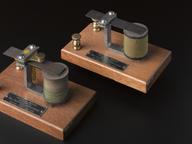

Replica of Bell's 1876 'iron-box' receiver, 1959
- Made:
- 1876 in Science Museum
- inventor:
- Alexander Graham Bell
- maker:
- Science Museum, Workshops

Replica of Bell's 1876 'iron box' receiver, made by Science Museum Workshops, South Kensington, London, England, 1959.
This was the type of receiver that Alexander Graham Bell (1847-1922) successfully demonstrated at the Centennial Exhibition in Philadelphia in 1876. During the spring of 1876, Bell had sought to improve the design of the tuned-reed receiver, as it was inefficient and required the device to be pressed closely to the ear in order to prevent the free vibration of the reed. He designed instead this cylindrical iron box. This type of receiver was also used in Bell's first successful one-way long distance telephone call, from his office in Brantford, Ontario, to his office in Paris, Ontario, a distance of 13 kilometres.
Details
- Category:
- Telecommunications
- Object Number:
- 1959-5
- Materials:
- iron, brass (copper, zinc alloy) and wood (unidentified)
- Measurements:
-
overall: 135 mm x 115 mm x 100 mm, .73kg
- type:
- telephone component
- credit:
- Made in museum




